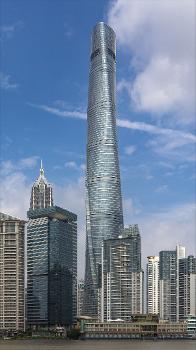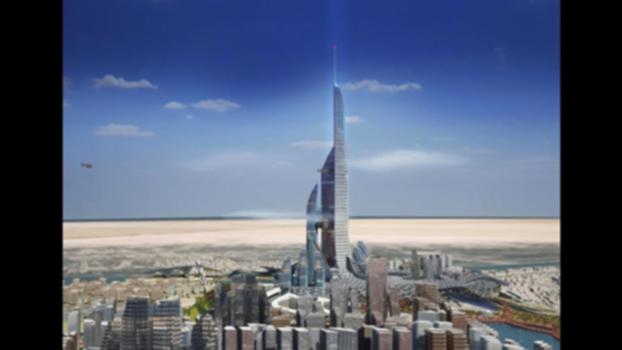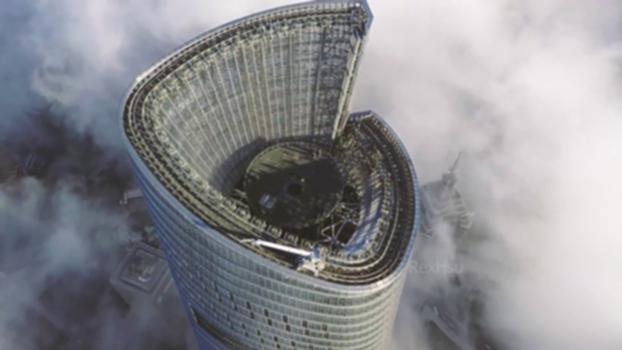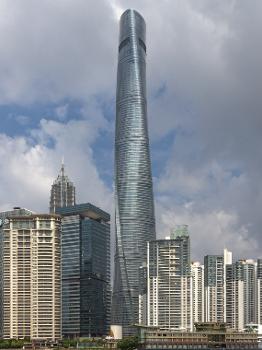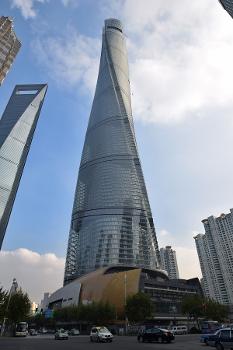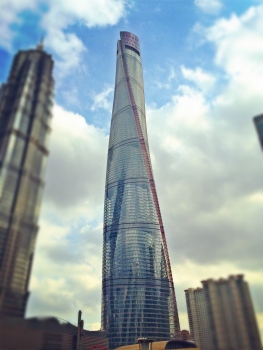General Information
| Name in local language: | 上海中心大厦 (Shànghǎi zhōngxīn dàshà) |
|---|---|
| Beginning of works: | 29 November 2008 |
| Completion: | 18 February 2015 |
| Status: | in use |
Project Type
| Function / usage: |
Office building Hotel Shopping center / Mall |
|---|---|
| Certification(s): |
for registered users |
Awards and Distinctions
| 2016 |
award winner
for registered users award winner for registered users award winner for registered users |
|---|
Location
Technical Information
Dimensions
| height | 632 m | |
| height to observation deck | 556 m | |
| number of floors (above ground) | 128 |
Chronology
| 29 November 2008 | The cornerstone is laid. |
|---|---|
| 3 August 2013 | Shanghai Tower reaches ist final height of 632 meter an becomes the tallest building in China and the second tallest world-wide after Burj Khalifa in Dubai as well as the third-tallest structure overall after Tokyo Sky Tree. |
Excerpt from Wikipedia
The Shanghai Tower (Chinese: 上海中心大厦; pinyin: Shànghǎi Zhōngxīn Dàshà; Shanghainese: Zånhe Tsonshin Dasa; literally: 'Shanghai Center Building') is a 632-metre (2,073 ft), 128-story megatall skyscraper in Lujiazui, Pudong, Shanghai. It shares the record (along with the Ping An Finance Center) of having the world's highest observation deck within a building or structure at 562 m, and the world's second-fastest elevators at a top speed of 20.5 metres per second (74 km/h; 46 mph). It is the world's second-tallest building by height to architectural top. However, the title of the world's fastest elevator now belongs to the Guangzhou CTF Finance Centre, with a top speed of 21 metres per second (76 km/h; 47 mph) achieved in 2017. Designed by international design firm Gensler and owned by the Shanghai city government, it is the tallest of the world's first triple-adjacent supertall buildings in Pudong, the other two being the Jin Mao Tower and the Shanghai World Financial Centre. Its tiered construction, designed for high energy efficiency, provides nine separate zones divided between office, retail and leisure use.
Construction work on the tower began in November 2008 and topped out on 3 August 2013. The exterior was completed in summer 2015, and work was considered complete in September 2015. Although the building was originally scheduled to open to the public in November 2014, the actual public-use date slipped considerably. The observation deck was opened to visitors in July 2016; the period from July through September 2016 was termed a "test run" or "commissioning" period. Since April 26, 2017, the sightseeing deck on the 118th floor has been open to the public.
Shanghai Tower is the winner of Tien-yow Jeme Civil Engineering Prize of 2018.
Planning and funding
Planning models for the Lujiazui financial district dating back to 1993 show plans for a close group of three supertall skyscrapers. The first of these, the Jin Mao Tower, was completed in 1999; the adjacent Shanghai World Financial Centre (SWFC) opened in 2008.
The Shanghai Tower is owned by Yeti Construction and Development, a consortium of state-owned development companies which includes Shanghai Chengtou Corp., Shanghai Lujiazui Finance & Trade Zone Development Co., and Shanghai Construction Group. Funding for the tower's construction was obtained from shareholders, bank loans and Shanghai's municipal government. The tower had an estimated construction cost of US$2.4 billion.
Design
The Shanghai Tower was designed by the American architectural firm Gensler, with Shanghainese architect Jun Xia leading the design team.
The tower takes the form of nine cylindrical buildings stacked atop each other, totalling 128 floors, all enclosed by the inner layer of the glass facade. Between that and the outer layer, which twists as it rises, nine indoor zones provide public space for visitors. Each of these nine areas has its own atrium, featuring gardens, cafés, restaurants and retail space, and providing panoramic views of the city.
Both layers of the façade are transparent, and retail and event spaces are provided at the tower's base. The transparent façade is a unique design feature, because most buildings have only a single façade using highly reflective glass to reduce heat absorption, but the Shanghai Tower's double layer of glass eliminates the need for either layer to be opaqued. The tower is able to accommodate as many as 16,000 people on a daily basis.
The Shanghai Tower joins the Jin Mao Tower and SWFC to form the world's first adjacent grouping of three supertall buildings. Its 258-room hotel, located between the 84th and 110th floors, is to be operated by Jin Jiang International Hotels as the Shanghai Tower J-Hotel, and at the time of its completion it will be the highest hotel in the world. The tower will also incorporate a museum. The tower's sub-levels provide parking spaces for 1,800 vehicles.
Vertical transportation system
The vertical transportation system for Shanghai Tower was designed by an American consultant, Edgett Williams Consulting Group, with principal Steve Edgett as primary consultant. Working closely with Gensler’s design and technical teams to create a highly efficient core, Edgett created an elevator system in which office floors are served via four sky lobbies each served by double-deck shuttle elevators. Access to the hotel is through a fifth sky lobby at levels 101/102. Each two-level sky lobby serves as a community centre for that zone of the building, with such amenities as food and beverage and conference rooms. Local zones are served by single deck elevators throughout the tower, and the observation deck at the top of the tower is served by three ultra-high speed shuttle elevators which travel at 18 metres per second (40 mph), the highest speed yet employed for commercial building use. These three shuttle elevators are supplemented by three fireman’s elevators which will significantly increase the visitor throughput to the observation deck at peak usage periods. In the event of a fire or other emergency, the building’s shuttle elevators are designed to evacuate occupants from specially-designed refuge floors located at regular intervals throughout the height of the tower.
In September 2011, Mitsubishi Electric Corp. announced that it had won a bid to construct the Shanghai Tower's elevator system. Mitsubishi supplied all of the tower's 149 elevators (108 of which are lifts), including three high-speed models capable of travelling at 1,080 metres (3,540 ft) per minute (64.8 kilometres (40.3 mi) per hour). When they were installed (2014), they were the world's fastest single-deck elevators (18 metres/second) and double-deck elevators (10 metres/second). A 10 May 2016 Mitsubishi press release stated that one of the three shuttle elevators had been installed to travel 1230 metres/minute – the equivalent of 73.8 kilometres per hour (46 mph), the highest speed ever attained by a passenger elevator installed in a functioning building. The building also broke the record for the world's furthest-travelling single elevator, at 578.5 metres (1,898 ft), surpassing the record held by the Burj Khalifa. The Shanghai Tower's tuned mass damper, designed to limit swaying at the top of the structure, was the world's largest at the time of its installation.
Sustainability
The Shanghai Tower incorporates numerous green architecture elements; its owners received certifications from the China Green Building Committee and the U.S. Green Building Council for the building's sustainable design. In 2013, a Gensler spokesman described the tower as "the greenest super high-rise building on earth at this point in time". The building is designed to capture rainwater for internal use, and to recycle a portion of its wastewater.
The design of the tower's glass façade, which completes a 120° twist as it rises, is intended to reduce wind loads on the building by 24%. This reduced the amount of construction materials needed; the Shanghai Tower used 25% less structural steel than a conventional design of a similar height. As a result, the building's constructors saved an estimated US$58 million in material costs. Construction practices were also optimised for sustainability. Though the majority of the tower's energy will be provided by conventional power systems, 270 vertical-axis wind turbines located in the facade and near the top of the tower are capable of generating up to 350,000 kWh of supplementary electricity per year, and are expected to provide 10% of the building's electrical needs. The double-layered insulating glass façade was designed to reduce the need for indoor air conditioning, and is composed of an advanced reinforced glass with a high tolerance for temperature variations. In addition, the building's heating and cooling systems use geothermal energy sources. Furthermore, rain and waste water are recycled to flush toilets and irrigate the tower’s green spaces.
Construction
In 2008, the site – previously a driving range – was prepared for construction. A groundbreaking ceremony was held on 29 November 2008, after the tower had passed an environmental impact study. The main construction contractor for the project was Shanghai Construction Group, a member of the consortium that owns the tower.
A repetitive slip-forming process was used to construct the tower's core floor by floor. By late April 2011, the tower's steel reinforcement had risen to the 18th floor, while its concrete core had reached the 15th floor, and floor framing had been completed up to the fourth floor. By late December 2011, the tower's foundations had been completed, and its steel construction had risen above the 30th floor. By early February 2012, the tower's concrete core had risen to a height of 230 metres (750 ft), with around fifty floors completed. In the first months of 2012, cracks began appearing in the roads near the tower's construction site. These were blamed on ground subsidence, which was likely caused by excessive groundwater extraction in the Shanghai area, rather than by the weight of the Shanghai Tower.
By May 2012, the tower's core stood 250 metres (820 ft) high, while floors had been framed to a height of 200 metres (660 ft). By early September 2012, the core had reached a height of 338 metres (1,109 ft). By the end of 2012, the tower had reached the 90th floor, standing approximately 425 metres (1,394 ft) tall. By 11 April 2013, the tower had reached 108 stories, standing over 500 metres (1,600 ft) tall and exceeding the heights of its two neighbouring supertall skyscrapers, the Jin Mao Tower and the Shanghai World Financial Centre.
Construction crews laid the final structural beam of the tower on 3 August 2013, thus topping out the tower as China's tallest, and the world's second-tallest, building. A topping-out ceremony was held at the site of the last beam. During the ceremony, Gensler co-founder Art Gensler stated:
The Shanghai Tower represents a new way of defining and creating cities. By incorporating best practices in sustainability and high-performance design, by weaving the building into the urban fabric of Shanghai and drawing community life into the building, Shanghai Tower redefines the role of tall buildings in contemporary cities and raises the bar for the next generation of super-highrises.
The principal architect of the project, Jun Xia, said “With the topping out of Shanghai Tower, the Lujiazui trio will serve as a stunning representation of our past, our present and China’s boundless future." Gu Jianping, general manager of the Shanghai Tower Construction Company, expressed the firm's wish "to provide higher quality office and shopping space, as well as contribute to the completeness of the city skyline's and the entire region's functionality".
In January 2014, the tower's crown structure passed the 600-metre (2,000 ft) mark, as its construction entered its final phase. The tower's crown structure was completed in August 2014, and its façade was completed shortly after. The tower's interior construction and electrical fitting-out were completed in late 2014. The opening was gradually introduced during the summer of 2016.
Tenants
The tower has faced problems attracting tenants due to the absence of all the necessary permits from the local fire department, and consequent impossibility to obtain the official occupancy permit (eventually obtained at end of June 2017). Following a report in June 2017, approximately 60% of its office space has been leased out, but only 33% of those tenants have moved in, leaving entire floors of the tower completely empty; the luxury J hotel has also yet to open. The tenants of the tower include Alibaba, Intesa Sanpaolo and AllBright Law Offices.
Text imported from Wikipedia article "Shanghai Tower" and modified on July 23, 2019 according to the CC-BY-SA 4.0 International license.
Participants
Relevant Web Sites
Relevant Publications
- (2014): 121-story Shanghai Center Tower foundation re-analysis using a compensated pile foundation theory. In: The Structural Design of Tall and Special Buildings, v. 23, n. 11 (10 August 2014), pp. 854-879.
- (2017): The Acceleration demand of the outer-skin curtain wall system of the Shanghai Tower. In: The Structural Design of Tall and Special Buildings, v. 26, n. 5 (10 April 2017), pp. e1341.
- (2016): Design and Study of Super Suspend Curtain Wall Support Structure of Shanghai Tower. Presented at: IABSE Congress: Challenges in Design and Construction of an Innovative and Sustainable Built Environment, Stockholm, Sweden, 21-23 September 2016, pp. 2771-2778.
- (2015): Development and application of construction monitoring system for Shanghai Tower. In: Smart Structures and Systems, v. 15, n. 4 (April 2015), pp. 1019-1039.
- (2017): The Drift demand of the outer-skin curtain wall system of the Shanghai Tower. In: The Structural Design of Tall and Special Buildings, v. 26, n. 17 (10 December 2017), pp. e1388.
- About this
data sheet - Structure-ID
20045534 - Published on:
21/06/2009 - Last updated on:
07/09/2023

